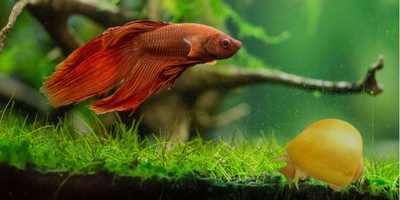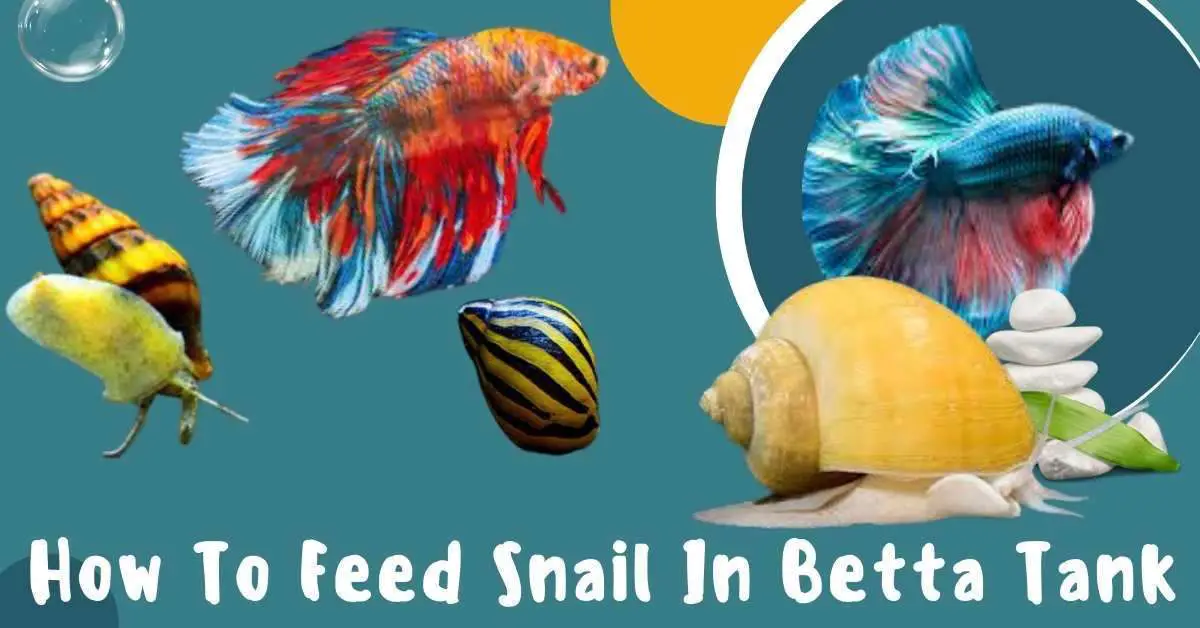Do you have snails in your betta tank? If so, you may be wondering how to feed them properly. It can be tricky, as snails are not known for being finicky eaters. However, you can do a few things to ensure that your snail gets the nutrition it needs.
Snails are a great addition to any betta tank; they can help keep the tank clean and free of algae. However, it is essential to note that snails cannot survive on betta pellets (feed) alone. They need a variety of fresh foods to stay healthy and happy. This guide will discuss what type of food snails need and how to feed them properly.

Snails are scavengers. They eat any potential food that they can have on the bottom surface. As Bettas are surface feeders, they would eat most of the food before it reaches the bottom of the tank. We should keep in mind to provide our snails with food that would settle on the bottom surface of their tank.
There are a variety of different food options that snails can eat in a betta tank. Some common choices include algae pellets, blanched vegetables, and frozen or freeze-dried bloodworms. It is essential to offer various food options to ensure that your snail gets the nutrients it needs.
However, we will show you an easier way to feed snails in a betta fish tank with the following fewer steps:
Choose natural vegetables
First, snails are heavily herbivores, so their diet naturally includes plants. If you’ve ever seen a snail in the wild, you’ll notice that they spend a lot of time grazing on vegetation. In captivity, snails will also seek any edible plants that they can find.
Snails like to eat vegetables because they need fiber to help them digest their food correctly. Without enough fiber, snails can get constipated, which can be pretty dangerous for them. Eating vegetables is an excellent way for snails to get their daily dose of vitamins and minerals. While most snails get all the nutrients they need from their food; sometimes they can benefit from a little extra boost.
Snails can eat a variety of vegetables in a fish tank. Some common vegetables safe for snails include lettuce, carrots, kale, and cucumbers.
Blanching vegetables
One of the significant reasons for blanching vegetables for your snail is that blanched vegetables will sit perfectly on the fish tank bottom. This way, the snail can have full access to eat them.
There are also a few reasons blanching vegetables is suitable for snails in a fish tank.
First, blanching helps to remove any dirt or debris that may be on the vegetables. It is essential because it helps keep the tank’s water clean.
Second, blanching helps to soften the vegetables, which makes them more accessible for the snails to eat.
Finally, blanching helps to keep the nutrients in the vegetables, which are essential for the health of the snails.
Blanching is easy! For example, we’ll show you how to blanch kale and cucumbers. These are the two easy blanching options you can try.
Blanching cucumbers
We all know how important it is to provide our snails with a nutritious diet, but sometimes it isn’t easy to understand what they can and can’t eat. Cucumbers are a significant source of vitamins and minerals for snails, but they must be prepared correctly before eating them. Here’s a step-by-step guide to blanching cucumbers for your snail:
- Start by washing the cucumbers thoroughly. You don’t want to introduce dirt or bacteria into your snail’s diet.
- Cut the cucumbers into small pieces that will be easy for your snail to eat.
- Bring a pot of water to a boil and then carefully add the cucumber pieces.
- Let the cucumbers cook for 2-3 minutes.
- Remove the cucumbers from the pot and place them in a bowl of iced water. It will stop the cooking process and help preserve the cucumbers’ nutrients.
- Once the cucumbers are cool, they’re ready to be eaten by your snail.
Blanching kale
Kale is a great food for snails and is an excellent source of vitamins and minerals. It is also low in calories and fat, making it an ideal food for snails. Blanching kale is a simple process that allows you to soften the kale so that your snail can quickly eat it. It also helps to preserve the nutrients in the kale.
Blanching kale to feed snails in the fish tank is a process that is easy but requires some forethought and preparation. Here are the steps to properly blanch kale to feed your snail in the fish tank:
1) Fill a pot with water and bring it to a boil.
2) Cut the kale into small pieces, removing any tough stems.
3) Add the kale to the boiling water and let it cook for 3-5 minutes.
4) Drain the kale in a colander or strainer.
5) Rinse the kale with cold water to stop the cooking process.
6) You can now save them in a freezer and use them as needed.
7) Feed the kale to your snails and watch them. Enjoy!
Take off extra food
It is essential to pick up any extra food that falls to the bottom of the tank. This food can rot and release harmful toxins into the water, harming your fish. You can use a siphon or a small net to pick up extra food. First, turn off the filter and pump. Then, place the siphon tube into the tank and start the siphon by sucking on the tube. The water will flow into the tube, leaving the food behind.
Alternatively, you can use a small net to scoop up the food. Be careful not to disturb the gravel or decorations in the tank.
Once you have collected all the extra food, you can turn the filter and pump back on.
FAQs
Q: Can I have snails in my betta tank?
A: Yes, you can have a snail in your betta tank, but choosing the suitable snail for your betta is essential. Some snails are very active and may disturb your betta’s peace. It is best to select a snail that is not too active and is the right size for your tank.
Q: What kind of snails can be with betta fish?
A: Many snails can be kept with betta fish, but some of the most popular options include nerite snails, mystery snails, and Assassin snails. These types of snails are peaceful and can coexist peacefully with bettas.
Q: How long can snails go without food?
There is no definitive answer to this question as it depends on several factors, such as the type of snail, the temperature and humidity of its environment, and its access to water. However, snails can survive for several weeks without food.
Q: What do snails eat in a fish tank?
A: Snails are scavengers, so they eat almost anything they can find in the tank. It includes uneaten fish food, algae, and even dead fish. Having a good balance of food sources for your snail population is essential so they don’t start eating the live plants in the tank.
Q: How often should I feed my snails?
A: Feed your snails once a day, making sure there is enough food available for them to eat. If you notice that your snail population is dwindling, you may need to increase the feeding frequency.
Q: What happens if I overfeed my snails?
A: Overfeeding your snails can lead to severe problems, including obesity and shell deformities. Please make sure you only feed them as much as they can eat in a day and remove any uneaten food from the tank afterward.
Concluding Remarks
Overall, it is easy to feed snails in a betta tank. By following the above steps, you can ensure that your snails have a nutritious and well-rounded diet. In addition, by providing them with a hiding place and plenty of fresh water, you can create a comfortable environment for them to live in. Following these simple tips, you can provide your snails with everything they need to thrive in your betta tank.

